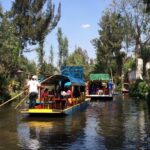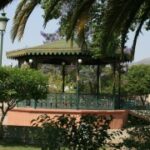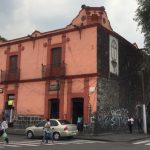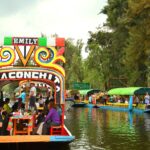
The Barrio San Juan Bautista Tlateuhchi includes the area of the Fernando Celada Boat Launch, and the area to the immediate east and north of the boat launch. It’s some of the first canal-side land that the many passengers on the canal will see. Tlateuhchi, the Náhuatl name, means “place where the earth is leveled.”
The neighborhood is well-known for being built around an important ancient ceremonial site. Perhaps, even more noteworthy are the “flying buttresses” that help hold up the neighborhood church. Remains of some of the ancient temple certainly went into the church, if not the buttresses. Some ancient inscriptions can be observed both inside and out.
Work began on a previous building, probably during the 16th century. This building was entirely rebuilt in about 1730. The base of the bell tower bears an inscription bearing this date.
The main façade of the Chapel of Saint John the Baptist is covered in lime and sand. It consists of a single nave and bell tower. Capacity is only 80 people. The church is painted, often a new color, every few years. The interior is composed by three semicircular arches, forming a half-barrel vault in a Neo-classical style. You’ll find the altarpiece and ábside essentially bare. But a statue of St. John the Baptist stands out as does a figure of Christ holding the cross.
The dome, done in the Mudejar style, has echoes of Arab Christian design. The style became very popular during and after the Moorish rule over Spain. The dome has eight windows crowned with friezes, a lantern, and a cross.
It’s an 11-minutes walk from the Xochimilco light-rail. The church and plaza are even closer to the boat launch. The Plaza de San Juan Bautista is home to a much-loved ahuehuete tree, known as El Sabino. An old, dramatic, and twisted giant of a tree, it’s very much a symbol for the Barrio San Juan. According to legend, the tree is 500 years old and was planted by the Emperor Cuauhtémoc in honor of the Xochimilca people’s support in the defense of Mexico-Tenochtitlán.
Walking down Calle Sabino, named for the tree, it’s only about 6 minutes back to the Cathedral and the Market. It’s easy to get a bit lost in San Juan. Rest assured, every corner leads to another discovery, and it’s all terribly close to the Xochimilco Center.

Nearest at 0.21 kms.

Nearest at 0.28 kms.

Nearest at 0.28 kms.

One of the oldest houses in Mexico City, and a unique take on Xochimilco...

The quickest easiest way to the canals of Xochimilco...

A teeming hive of commerce, culture, and food, it's a spectacular place for lunch and more.

The Cuemanco Boat Launch at Xochimilco Lake is one of the biggest and most publicly accessible trajinera launches in Xochimilco.

One of the closest "ecological" boat launches in Xochimilco, you'll set off for the deepest and most verdant canals.